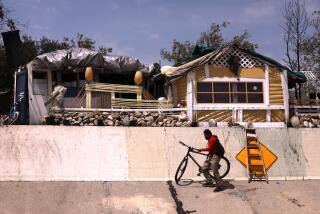New Georgia Park’s Shabby, but Not Chic
- Share via
AMERICUS, Ga. — The Happiest Place on Earth, it’s not.
For tourists who plunk down a $5 donation to visit this unconventional new park, the payoff is not heart-soaring fantasy, but a sense of the shabby living conditions of the world’s poor. There are no rides, no make-believe Main Streets. The only path wends through a mock slum of ragged shacks and improvised furnishings that is meant to represent the squalid quarters inhabited by millions of impoverished people around the globe.
The six-acre park opened its gates June 7 as a project of Habitat for Humanity International, the nondenominational Christian charity that builds homes for the poor in 88 countries and more than 1,600 U.S. cities. Called the Global Village & Discovery Center, the park is designed to be a conscience-tugging tourist destination and a tool for teaching about Habitat’s house-building projects and raising money for them.
The park, built on donated land that once held a peanut-processing plant, is an attempt to bring to life for visitors the realities of the most severe poverty overseas, since very few Americans venture into places where such abject conditions exist, said Millard Fuller, a former missionary and founder of Habitat for Humanity.
“It’s real authentic -- except for the odor,” Fuller said. “A real situation like that would have an odor.”
Some commentators have ridiculed the notion of vacationers choosing a poverty park over more familiar diversions, and Fuller acknowledged that the site may be a hard sell for visitors seeking only to be entertained. But he said most people -- including the thousands who have donated time or money to build Habitat houses -- would find educational value in the display of slum conditions. The park, which will cost $4.5 million by its planned completion in 2005, is funded separately from Habitat’s house-building arm.
Officials hope to attract 50,000 to 70,000 visitors yearly to the Global Village, which sits a short drive from two other tourist magnets in south Georgia: the childhood home of former President Jimmy Carter in Plains and the Andersonville National Historic Site, where a Civil War prison camp stood. Attendance is running behind the hoped-for pace, but officials say it’s still early. On a recent weekday afternoon, there were only a few visitors.
Florence Reilly, touring with her husband and son, said it was sobering to learn that such slum conditions persisted. “I thought this was from back 100 years ago. I asked our guide when this was from and she said people still live like that,” said Reilly, who works for a carpet company and lives in a four-bedroom house in the north Georgia town of Dalton. “I found it incredible.”
Tears pooled in her eyes as she considered a parent’s travails. “I can’t imagine raising a child under those conditions,” she said. “They’d have to suffer to see their children suffering.”
As an uplifting counterpoint to the model slum, the park displays 15 new homes similar to those that Habitat volunteers have built abroad, from concrete block homes in Guatemala to compressed-earth block homes in Ghana. Leaders hope the examples will inspire visitors to pull out their checkbooks and contribute toward building homes, which can be erected for $2,100 to $6,500. As many as 30 more model houses from around the world are to be built on the grounds by the time the park is finished.
Global Village visitors won’t find displays of substandard U.S. housing -- a fact that bothers some. Lynne Griever, statewide coordinator for the Georgia Task Force for the Homeless, praised the work of Habitat and its goals for the new park, but said visitors should also come away with a sense of urgency about the growing ranks of Americans left homeless because they cannot afford housing.
She proposed adding displays of the makeshift tents made of plastic draped over sticks or the run-down shacks found in this country.
“I would just like to shift the focus, or add the focus, that the United States is in serious trouble in terms of affordable housing,” Griever said.
Habitat officials said they plan to address that concern soon.
A corner of the park that will focus on U.S. poverty will feature a rusting mobile home that was donated by a local woman and her brother. The pair lived in it for nearly three decades before moving into a house built by volunteers. Fuller said that while Habitat builds across the United States, the slum display was meant to bring home the severity of conditions not seen even in the most impoverished U.S. communities.
To illustrate those conditions, park planners relied on photographs of impoverished neighborhoods and on the expertise of Habitat volunteers who had worked in foreign settings. The result is a cramped ersatz slum that is likely to be familiar to those who have set foot in poorer corners of the developing world.
The shanties were built with the same jumble of mismatched materials -- rusting tin sheets, ill-fitting wood scraps, tarpaulin -- as those salvaged for use as building materials in places such as Latin America and Africa. Bare mattresses and children’s sleeping bags lie on floors of dirt and cardboard, or rough wood. Doors hang unsteadily, or are absent, and cloth scraps serve as curtains over window cavities. A mock provisions shop, barely bigger than a telephone booth, employs an old car hood as its awning -- a reflection of the ingenious ways that discarded items, from old tires to cast-off fixtures, are converted into useful building materials.
The park’s executive director, Dick Kuegeman, a consultant who has developed and managed theme parks around the country, said designers had a tricky job in creating a display that was realistic but still safe for visitors.
“It can’t be so accurate that there are stagnant pools of water on the ground that breed mosquitoes,” he said. “It can’t have jagged edges that snag your sleeve.”
To make the park more realistic, employees have at times burned wood and paper in a barrel out of sight to create the scent of smoke hanging over many rural villages. Kuegeman said park officials plan to install a display of a communal latrine too.
More to Read
Sign up for The Wild
We’ll help you find the best places to hike, bike and run, as well as the perfect silent spots for meditation and yoga.
You may occasionally receive promotional content from the Los Angeles Times.






